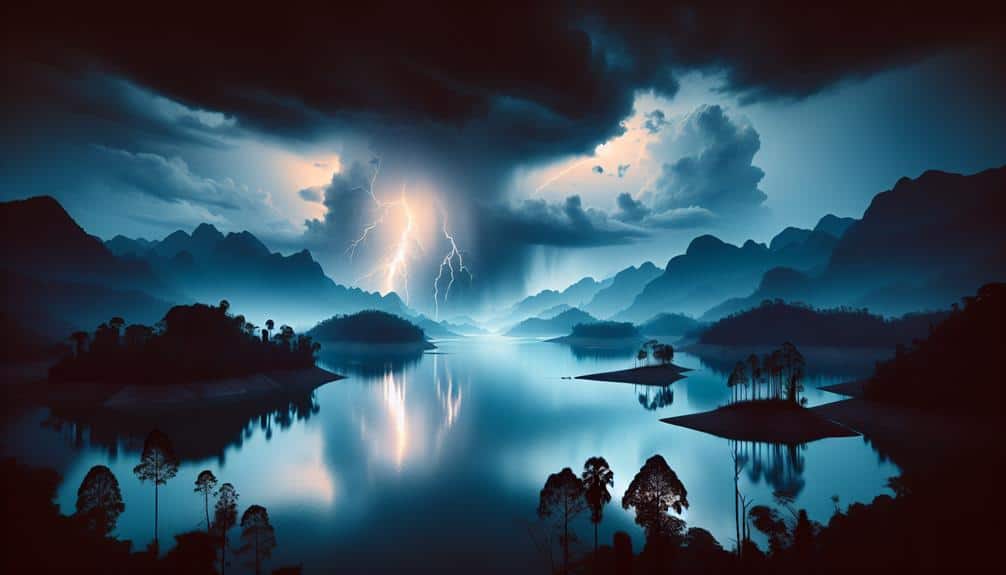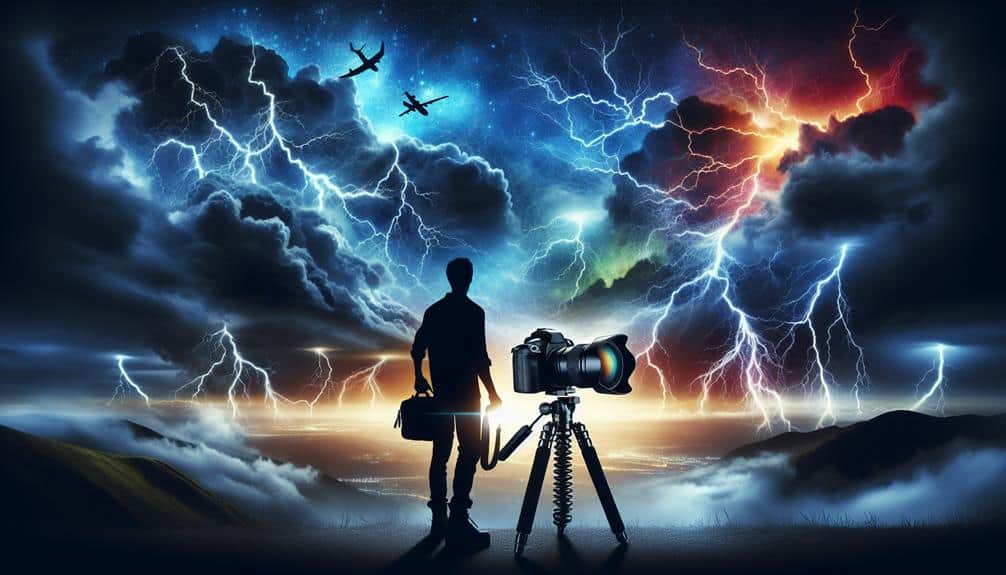To capture lightning strikes with unique perspectives, we use wide-angle lenses to encompass vast stormscapes and urban skylines to contrast human structures against nature's fury. High-altitude views, often achieved through drones, provide unmatched stability and precision. Coastal scenes offer the dynamic interplay of water and lightning, while reflections in water double the visual spectacle. For atmospheric drama, we highlight silhouettes against flashing skies. To capture the intricate details of supercells, we use high-speed cameras and Doppler radar. Adjusting our camera settings for low lighting guarantees high-quality images. Each technique offers a distinct framework for capturing this electrifying phenomenon in more detail.
Key Points
- Capture expansive lightning storms using wide-angle lenses for dramatic, all-encompassing shots.
- Contrast lightning strikes with urban skylines for unique cityscape photos.
- Utilize high-altitude views or drones for stable and precise lightning captures.
- Incorporate reflections in water to create visually impactful double lightning images.
Wide-Angle Landscape Shots
Wide-angle landscape shots allow us to capture the expansive scope of a lightning storm, providing both context and scale to each strike. By using a wide-angle lens, we can document the vastness of mountain vistas or the endless stretch of desert horizons, enhancing the dramatic effect of the stormy skies. This technique ensures that the enormity of the electrical storm is fully represented, highlighting the intricate patterns and pathways of lightning as it traverses the sky.
In terms of technical accuracy, employing a lens with a focal length between 10mm and 24mm is ideal. This range allows us to encompass wide scenes without distorting the image excessively. When photographing in areas like mountain vistas, the wide-angle view captures the rugged terrain alongside the storm, offering a juxtaposition of the earth's stability against the sky's volatility. Conversely, in desert horizons, the vast, open spaces emphasize the isolation and sheer power of the electrical storms.
To maximize image quality, we should use a tripod to stabilize the camera, reducing motion blur during long exposure shots. By combining these techniques, we can create compelling, expansive images that convey the raw power and beauty of nature's most electrifying phenomena.
Urban Skyline Strikes
While capturing the vastness of nature offers a raw and expansive view, photographing lightning strikes against an urban skyline introduces a striking contrast between human engineering and natural phenomena.
Rooftop photography provides us with an unparalleled vantage point for observing cityscape contrasts, where the interplay of artificial lights and natural lightning creates a surreal visual tapestry.
Street level strikes allow us to witness urban electricity in action, offering a front-row seat to the dramatic interaction between lightning and towering skyscrapers.
To capture the perfect shot, we must consider several factors:
- Location Scouting: Identify buildings with open rooftops for unobstructed views. High-rise apartments and office buildings often provide the best angles.
- Weather Forecasting: Use reliable meteorological data to predict storm patterns and increase our chances of capturing lightning events.
- Camera Settings: Opt for long exposure times and low ISO settings to capture the full brilliance of each strike without overexposing the city lights.
- Safety Precautions: Never underestimate the power of lightning. Maintain a safe distance and avoid metal structures during active storms.
High-Altitude Views
Let's explore high-altitude views that utilize elevated camera placement and drone lightning photography.
By positioning cameras at higher altitudes, we can capture lightning strikes with greater clarity and less atmospheric interference.
Utilizing drones, we gain the advantage of mobility, allowing us to obtain dynamic and diverse perspectives on lightning phenomena.
Elevated Camera Placement
How can we best leverage elevated camera placement to capture high-altitude views of lightning strikes?
By strategically positioning our cameras in elevated locations, we can achieve unparalleled perspectives that provide both visual drama and scientific value.
Here are four key strategies:
1. Rooftop Angles:
Utilizing rooftops in urban areas provides a stable and accessible platform for capturing lightning. The height advantage minimizes obstructions and maximizes the field of view.
2. Mountain Perspectives:
Setting up cameras on mountain ridges grants expansive, unobstructed panoramas. These high-altitude settings often coincide with storm paths, offering frequent lightning activity.
3. Tree Canopy:
Positioning cameras within tall tree canopies allows us to get close to lightning strikes while maintaining a natural frame. This method immerses the viewer in the environment, creating a unique perspective.
4. Aerial Shots:
Fixed aerial installations, such as those on tall towers or observation decks, provide stable platforms for long-term monitoring. These vantage points are ideal for time-lapse photography and data collection.
Drone Lightning Photography
Drone technology enables us to capture high-altitude views of lightning strikes with unprecedented precision and flexibility, offering new opportunities for both visual documentation and atmospheric research. By deploying drones equipped with advanced lightning detection systems and high-resolution cameras, we can achieve aerial perspectives that were previously unattainable. These perspectives allow us to observe the intricate structures of lightning channels and their interaction with storm systems in real-time.
When storm chasing, drones provide a safer and more efficient means to position our equipment in ideal locations without exposing ourselves to dangerous conditions. The agility and range of modern drone technology enable us to track storms dynamically, obtaining data from multiple angles and altitudes. This capability is essential for enhancing our understanding of lightning formation, propagation, and dissipation.
Additionally, drones facilitate the collection of atmospheric data such as temperature, humidity, and wind speed at various altitudes, which is invaluable for meteorological studies. By integrating this data with lightning detection and visual documentation, we can develop more accurate predictive models and improve early warning systems.
With drones, we aren't just capturing breathtaking images but also contributing to a deeper scientific understanding of one of nature's most electrifying phenomena.
Coastal and Oceanic Scenes
Capturing lightning strikes over coastal and oceanic scenes demands precise timing and an understanding of atmospheric conditions unique to these environments. We must consider beachfront storms, where the interplay between land and sea creates dynamic weather patterns. The challenge lies in predicting when and where these electrifying displays will occur, especially when dealing with underwater lightning phenomena that can light up entire seascapes.
To maximize our success in capturing these awe-inspiring moments, we should follow a focused approach:
- Weather Forecasting: Utilize high-resolution atmospheric models to predict stormy horizons and the likelihood of lightning strikes.
- Optimal Equipment: Use waterproof and salt-resistant gear to withstand harsh coastal conditions.
- Location Scouting: Identify vantage points where land meets sea, offering unobstructed views of both the horizon and the sky.
- Timing: Understand tidal movements and their impact on storm development to plan the perfect shot.
Reflections in Water

Reflections in water present a unique opportunity to double the visual impact of lightning strikes, producing a mirror-like effect that heightens the drama and intensity of the scene. By harnessing the reflective properties of water, we can capture the fleeting beauty of lightning in a manner that's both scientifically intriguing and visually stunning.
When photographing lightning strikes above a body of water, we must take into account the rippling reflections generated by turbulent waters. These ripples introduce a dynamic aspect to our images, turning the stationary reflection of the lightning into a vibrant, living component of the scene. Selecting the appropriate moment—preferably when the water is tranquil enough to reflect clearly yet exhibits some movement to enhance texture—is crucial.
Information from meteorological research suggests that the optimal conditions for capturing these reflections typically arise during the initial phases of a thunderstorm when the water surface remains relatively undisturbed. Our camera settings should be adjusted for dim lighting situations, focusing on a prolonged exposure time to capture the entire duration of the lightning strike and its mirrored image. This approach guarantees that we fully exploit the dramatic interaction between the lightning and its undulating reflections, crafting a captivating visual story.
Dramatic Silhouettes
Incorporating dramatic silhouettes into our lightning photography allows us to emphasize the stark contrast between the illuminated sky and the darkened foreground elements, creating a visually compelling and scientifically informative image. This technique leverages shadow play to craft dynamic compositions that enhance the viewer's experience and understanding of atmospheric phenomena.
By focusing on silhouettes, we can achieve multiple objectives:
- Highlight Atmospheric Contrast: Capture the variance between the electric sky and the solid, dark shapes in the foreground.
- Emphasize Bold Shapes: Utilize natural elements like trees or buildings to anchor the scene, providing context and scale.
- Enhance Visual Impact: The juxtaposition of light and shadow creates a dramatic effect that draws the viewer's attention.
- Provide Scientific Insight: Detailed foreground elements can offer clues about the environment where the lightning occurs.
Supercell Close-Ups

When we zoom in on supercells, we uncover intricate structures and dynamic processes that reveal the true power and complexity of these severe storm systems. Supercells are highly organized, rotating thunderstorms characterized by a mesocyclone—a deep, persistently rotating updraft.
For storm chasers, capturing the raw intensity of these phenomena requires both precision and courage, as we navigate through extreme weather conditions to document the interplay of wind, rain, and lightning bolts.
Data-driven analysis shows that supercells can produce the most violent tornadoes and large hail. Using Doppler radar, we can observe the velocity and reflectivity patterns within the storm, identifying areas of significant rotation and potential lightning strike activity.
The power of nature is on full display within these turbulent systems, and each lightning bolt is a reflection of the immense electrical energy generated by the friction of ice particles within the storm's core.
To capture these moments with technical accuracy, we rely on high-speed cameras and lightning detectors. By positioning ourselves strategically, we can document the supercell's evolving anatomy, from the towering cumulonimbus clouds to the spectacular lightning displays that illuminate the night sky.
Frequently Asked Questions
How Do I Ensure My Camera Equipment Is Safe During a Lightning Storm?
We've got to prioritize equipment protection by using safety precautions, like waterproof covers and grounding. Monitor weather conditions closely and use lightning triggers to capture strikes from a safe distance, ensuring our safety and our gear's integrity.
What Settings Should I Use for Photographing Lightning at Night?
Did you know 80% of dramatic lightning photos use long exposure techniques? We should set our cameras to a 15-30 second shutter speed. Ideal weather conditions, a sturdy tripod, and remote shutter release are essential camera accessories.
Are There Smartphone Apps That Can Help Predict Lightning Strikes?
Yes, there are smartphone apps that offer lightning detection with impressive accuracy. Leveraging advanced technology, these apps use real-time data and sophisticated algorithms to predict lightning strikes, enhancing our ability to capture stunning lightning photography safely.
How Can I Minimize Noise in Long-Exposure Lightning Photos?
To minimize noise in long-exposure lightning photos, we should use noise reduction techniques during exposure. Additionally, applying advanced editing techniques and focusing on composition can greatly enhance image quality while preserving the scene's natural brilliance.
What Are the Best Safety Practices for Storm Chasing Photographers?
Remember when we almost got caught in that storm? Storm safety is essential; always check weather updates and have an exit plan. For equipment protection, use waterproof covers and stabilize your gear to withstand high winds. Stay safe!


